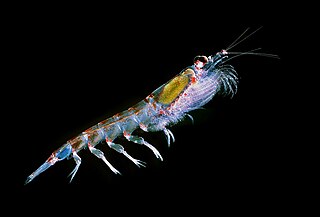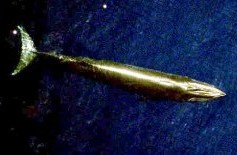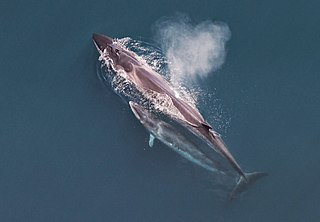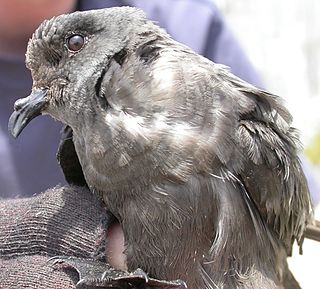
Antarctic krill is a species of krill found in the Antarctic waters of the Southern Ocean. It is a small, swimming crustacean that lives in large schools, called swarms, sometimes reaching densities of 10,000–30,000 individual animals per cubic metre. It feeds directly on minute phytoplankton, thereby using the primary production energy that the phytoplankton originally derived from the sun in order to sustain their pelagic life cycle. It grows to a length of 6 centimetres (2.4 in), weighs up to 2 grams (0.071 oz), and can live for up to six years. It is a key species in the Antarctic ecosystem and in terms of biomass, is one of the most abundant animal species on the planet – approximately 500 million metric tons.

The fin whale, also known as the finback whale or common rorqual, is a species of baleen whale and the second-longest cetacean after the blue whale. The biggest individual reportedly measured 26 m (85 ft) in length, with a maximum recorded weight of 77,000–81,000 kg (170,000–179,000 lb). The fin whale's body is long, slender and brownish-gray in color, with a paler underside to appear less conspicuous from below (countershading).

Bryde's whale, or the Bryde's whale complex, putatively comprises three species of rorqual and maybe four. The "complex" means the number and classification remains unclear because of a lack of definitive information and research. The common Bryde's whale is a larger form that occurs worldwide in warm temperate and tropical waters, and the Sittang or Eden's whale is a smaller form that may be restricted to the Indo-Pacific. Also, a smaller, coastal form of B. brydei is found off southern Africa, and perhaps another form in the Indo-Pacific differs in skull morphology, tentatively referred to as the Indo-Pacific Bryde's whale. The recently described Omura's whale, was formerly thought to be a pygmy form of Bryde's, but is now recognized as a distinct species. Rice's whale, which makes its home solely in the Gulf of Mexico, was once considered a distinct population of Bryde's whale, but in 2021 it was described as a separate species.

Krill(Euphausiids), are small and exclusively marine crustaceans of the order Euphausiacea, found in all the world's oceans. The name "krill" comes from the Norwegian word krill, meaning "small fry of fish", which is also often attributed to species of fish.

The sei whale is a baleen whale. It is one of ten rorqual species, and the third-largest member after the blue and fin whales. They can grow up to 19.5 m (64 ft) in length and weigh as much as 28 t. Two subspecies are recognized: B. b. borealis and B. b. schlegelii. The whale's ventral surface has sporadic markings ranging from light grey to white, and its body is usually dark steel grey in colour. It is among the fastest of all cetaceans, and can reach speeds of up to 50 km/h (31 mph) over short distances.

The ashy storm petrel is a small, scarce seabird of the storm petrel family Hydrobatidae. It breeds colonially on islands off the coasts of California and Mexico, and is one of six species of storm petrel that live and feed in the rich California Current system.

Cassin's auklet is a small, chunky seabird that ranges widely in the North Pacific. It is the only species placed in the genus Ptychoramphus. It nests in small burrows and because of its presence on well studied islands in British Columbia and off California it is one of the better known auks. It is named for the American ornithologist John Cassin.

Euphausia pacifica, the North Pacific krill, is a euphausid that lives in the northern Pacific Ocean.

Euphausia is the largest genus of krill, and is placed in the family Euphausiidae. There are 31 species known in this genus, including Antarctic krill and ice krill from the Southern Ocean, and North Pacific krill in the Pacific Ocean.

Thysanoessa is a genus of the krill that play critical roles in the marine food web. They're abundant in Arctic and Antarctic areas, feeding on zooplankton and detritus to obtain energy. Thysanoessa are responsible for the transportation of carbon and nutrients from surface waters to deeper trophic levels. This genus serves as prey for various fish and provide energy to marine ecosystems as they are at a low trophic level. Most travel through vertical migration, meaning they travel up and down in the water column, providing food for predators at the surface during the night, and at deeper levels during the day.

The krill fishery is the commercial fishery of krill, small shrimp-like marine animals that live in the oceans world-wide. The present estimate for the biomass of Antarctic krill is 379 million tonnes. The total global harvest of krill from all fisheries amounts to 150–200,000 tonnes annually, mainly Antarctic krill and North Pacific krill.
Stygoporus oregonensis is a species of beetle in the family Dytiscidae, the only species in the genus Stygoporus.
Orchitophrya stellarum is a species of single-celled marine ciliates, a member of the class Oligohymenophorea. It is found living freely in the north Atlantic and Pacific Oceans but is also parasitic, being found inside the gonads of starfish.

Colliniidae is a family of ciliates of the order Apostomatida.
Pseudocollinia is a genus of parasitoid ciliate of the Colliniidae family.
Pseudocollinia brintoni is a species of parasitoid ciliates of the Colliniidae family. P. brintoni infects a species of krill, Nyctiphanes simplex.

Collinia is a genus of parasitoid ciliates of the Colliniidae family.
Collinia beringensis is a species of parasitoid ciliates of the Colliniidae family. It is an endoparasite of Thysanoessa inermis, a species of krill.
Miamiensis avidus is a species of unicellular marine eukaryote that is a parasite of many different types of fish. It is one of several organisms known to cause the fish disease scuticociliatosis and is considered an economically significant pathogen of farmed fish. M. avidus is believed to be the cause of a 2017 die-off of fish and sharks in the San Francisco Bay.
A metachronal swimming or metachronal rowing is the swimming technique used by animals with multiple pairs of swimming legs. In this technique, appendages are sequentially stroked in a back-to-front wave moving along the animal’s body. In literature, while metachronal rhythm or metachronal wave usually refer to the movement of cilia; metachronal coordination, metachronal beating, metachronal swimming or metachronal rowing usually refer to the leg movement of arthropods, such as mantis shrimp, copepods, antarctic krill etc. though all of them refer to the similar locomotion pattern.










